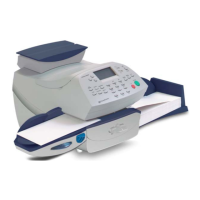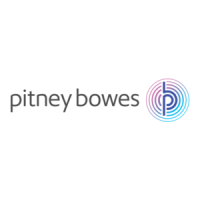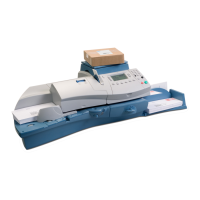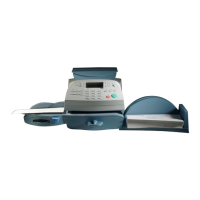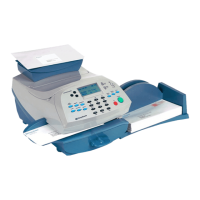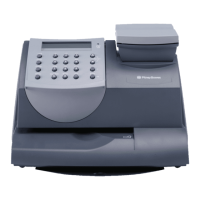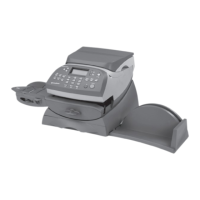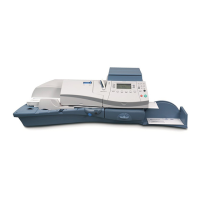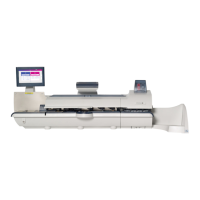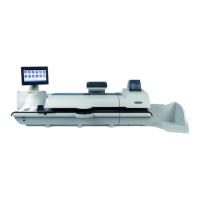Do you have a question about the Pitney Bowes DM400c series and is the answer not in the manual?
Details the advanced features and capabilities of the mailing system.
Explains IntelliLink technology for accessing services and information from Pitney Bowes.
Outlines essential requirements for using the mailing system with postal authorities.
Provides crucial safety precautions for operating the mailing system and general office equipment.
Lists technical specifications, including dimensions, weight, power, and performance for different models.
Identifies and describes the key components on the front of the DM300c model.
Identifies and describes the key components on the front of the DM400c model.
Identifies and describes the key components on the front of the DM475 model.
Details the function and operation of each key on the mailing system's control panel.
Identifies and describes the rear ports and switches for DM300c/DM400c models.
Identifies and describes the rear ports and switches for the DM475 model.
Provides instructions on how to safely move the DM300c and DM400c mailing systems.
Issues a critical warning against self-movement of the DM475 due to its complexity.
Lists essential pre-operation checks and considerations before running mail.
Explains the initial display shown after powering up the system and its basic navigation.
Describes various methods for selecting and applying postage to mail pieces.
Details the standard operation of the weighing platform for calculating postage.
Explains the differential weighing option for processing mixed mail by weight.
Guides on manually entering mail piece weight when the scale is not used.
Outlines how to directly enter postage amounts, specific to ROI users.
Details the DM475's WOW feature for automatic weighing and pricing.
Explains how to select accounts for tracking postage costs with accounting features.
Describes how to add custom messages or graphics to envelopes.
Explains how to manually set or advance the date for outgoing mail.
Covers viewing, printing, and resetting batch count information for mail runs.
Details the process of printing postage on envelopes and tape sheets.
Outlines various printing options like sealing only or adding date/time.
Explains how to create, select, view, and edit text messages for printing on mail.
Defines presets as saved machine settings for quick access to common configurations.
Describes the default preset settings and how they can be modified.
Explains how to select and use the system's default preset configuration.
Guides on how to view the current settings of the normal preset.
Details the process of updating the normal preset with new configurations.
Introduces custom presets, allowing storage of up to ten unique configurations.
Explains how to choose and apply a saved custom preset configuration.
Details how to review the saved settings of a custom preset.
Provides steps to create and save new custom preset configurations.
Guides on how to rename existing custom presets.
Explains how to replace an existing custom preset with new settings.
Details the procedure for removing custom presets from the system.
Explains the Postage by Phone system for obtaining postage funds and services.
Outlines the steps and requirements for adding postage funds to the machine.
Discusses the connection options (LAN or analogue phone line) for system services.
Provides details on connecting the mailing system to a Local Area Network.
Guides on connecting the system using a standard analogue phone line.
Explains how to check the current postage balance and funds.
Details how to verify the account balance for the Postage by Phone service.
Step-by-step instructions for adding postage funds to the machine.
Describes setting up a supervisor password and refill code for secure postage refills.
Explains how to generate a report of postage usage and remaining funds.
Details automatic downloads like software updates, ads, and postal rates.
Informs about available non-essential software updates for system enhancements.
Explains how to download and use new advertisements for mail.
Highlights important mandatory software updates necessary for system functionality.
Describes mandatory updates for postal code information.
Explains the mandatory postal audit process for UK users.
Details the mandatory postal inspection process for Republic of Ireland users.
Covers mandatory updates for postal rates to ensure accurate postage calculation.
Guides on connecting to the Data Centre for services other than adding postage.
Explains how to check for and download software and postal updates.
Introduces system options for customizing machine settings and security.
Covers fundamental system settings like time, language, display, and passwords.
Refers to date setting options explained in another chapter.
Details how to change the system's display language if multiple options are available.
Guides on modifying display contrast for better readability.
Explains how to set the function of the tape button for printing single or multiple tapes.
Covers setting system time, timeouts, and automatic date advance features.
Explains how to correct time drift due to internal factors or Daylight Saving Time.
Details how to enable or disable Daylight Saving Time for the system clock.
Configures a delay to allow automatic restart when mail is placed on the feed deck.
Sets warnings for low postage funds or high postage values.
Configures warnings for manually keyed postage values exceeding a set limit.
Sets up reminders to add postage when funds reach a low level.
Covers enabling, disabling, and changing the system's lock code and supervisor password.
Details options for scale configuration, including zeroing, auto-scale, and weight limits.
Explains how to modify phone connection settings for Data Centre communication.
Covers modifying phone connection parameters like dial type and prefix.
Allows modification of phone connection parameters for Data Centre calls.
Used to configure internet settings when connecting via a LAN.
Controls firewall settings when the system is connected via a LAN.
Sets how the system connects to Pitney Bowes services (Auto or Phone).
Provides access to infrequently used features like meter withdrawal.
Detailed instructions for replacing the ink cartridge or printhead.
Guides on filling the moistener tank with sealing solution for DM400c/DM475 models.
Guides on filling the moistener tank with sealing solution for DM300c models.
Covers cleaning the stripper blade, brush assembly, shield, and wick.
Explains how to perform print tests to check printhead performance and identify issues.
Details the process of purging printer nozzles to resolve printing problems.
Advises on what information to have ready when contacting support for assistance.
Provides steps to diagnose and resolve issues where the machine shows no display.
Lists common error messages and their descriptions with recommended actions.
Addresses issues related to printing, including seal-only mode and poor print quality.
Guides on avoiding and clearing stalled or jammed envelopes during feeding.
Mentions display issues like readability and contrast adjustment needs.
Covers issues related to connecting to the data centre for postage refills.
Addresses problems with envelopes not sealing correctly, including low sealant and brush issues.
Explains how to access system and firmware levels for troubleshooting.
Introduces optional features available to customize the mailing system.
Discusses the different capacity weighing platforms for accurate mail weighing.
Explains the function of the moistener for sealing envelopes.
Describes how advertisements can enhance mail appearance and promote services.
Details the optional accounting feature for tracking postage costs by department.
Provides information on how to order supplies, accessories, and options.
Lists essential supplies required for the mailing system's operation.
Introduces the various reports available for tracking funds, refills, and accounts.
Lists the details of the last five postage refills performed on the system.
Provides a report on postage used, available funds, and machine usage.
Shows postage history for a specific account when departmental accounting is enabled.
Summarizes postage history across multiple accounts for departmental accounting.
Lists all configured accounts, sorted by name, subaccount, and subsubaccount.
Details the history of data uploads to the data centre.
Lists the complete system configuration settings, useful for troubleshooting.
Provides a history of error codes encountered by the machine.
Lists configuration information about the machine and Postage by Phone account.
Lists the activity of each permit print if the system is used for permit printing.
Lists the versions of software used in the system, helpful for support.
Lists the versions of postal rates used by the system.
Explains the departmental accounting feature for tracking postage costs by individuals or departments.
Guides on enabling the departmental accounting feature on the system.
Explains how to temporarily disable the departmental accounting feature.
Details how to choose an account to track postage when accounting is active.
Provides steps to create new accounts for tracking postage usage.
Covers editing account details and setting up passwords for access control.
Enables the requirement for operators to enter passwords when selecting accounts.
Disables the requirement for operators to enter passwords for account selection.
Explains how to view the total postage used and pieces processed for each account.
Guides on clearing the accumulated postage totals for specific accounts.
Details the process of clearing postage totals for all accounts on the system.
Explains how to remove an account and its associated data from the system.
Introduces the INVIEW/Budget Manager optional accounting packages.
Guides on enabling and activating the INVIEW/Budget Manager accounting feature.
Explains how to temporarily disable the INVIEW/Budget Manager accounting feature.
Details how to log into the INVIEW/Budget Manager system based on operator setup.
Explains how to log out of the INVIEW/Budget Manager system.
Describes using PC Transfer Utility for backing up and restoring accounting data.
Explains uploading accounting data to the Accounting Server via webservice.
Discusses the requirement and connection of external memory for INVIEW/Budget Manager.
Details how to set a station ID for identifying mailing systems on accounting reports.
Guides on entering owner information for the Budget Manager system.
Explains setting up mandatory Job IDs for tracking transactions and postage spend.
Covers configuration of an optional barcode scanner for account/code scanning.
Details setting up operators with IDs and passwords for system access.
Guides on controlling operator functions, passwords, and log-off settings.
Explains how to structure accounts, subaccounts, and subsubaccounts.
Enables or disables the requirement for account passwords when selecting an account.
Provides steps to create new accounts within the INVIEW/Budget Manager system.
Guides on creating subaccounts and subsubaccounts linked to existing accounts.
Allows viewing and editing of account details, status, and passwords.
Explains how to remove an account and its associated data from the system.
Details the process of permanently erasing transaction data for accounts.
Sets the fiscal year start date and defines accounting periods for reporting.
Explains applying global surcharges or discounts per piece, transaction, or percentage.
Guides on choosing the method for applying global surcharges or discounts.
Explains various ways to select an account for printing postage.
Details how to enter batch surcharges for specific transactions.
Allows assigning Job IDs to transactions for tracking and management.
Provides steps to manually create transaction records in the system.
Explains how to correct transactions assigned to the wrong account.
Details how to clear the transaction log when it reaches full capacity.
Sets the percentage threshold for the log full warning notification.
Selects the action the system takes when the transaction log becomes full.
Lists the various custom and standard accounting reports available.
Guides on printing accounting reports using an attached printer.
Explains how to design and generate custom report formats.
Provides detailed steps for creating custom reports with selected data fields.
Guides on how to view or modify existing custom report formats.
Details the process for removing custom reports from the system.
Lists common error and warning messages encountered with INVIEW/Budget Manager.
Details the advanced features and capabilities of the mailing system.
Explains IntelliLink technology for accessing services and information from Pitney Bowes.
Outlines essential requirements for using the mailing system with postal authorities.
Provides crucial safety precautions for operating the mailing system and general office equipment.
Lists technical specifications, including dimensions, weight, power, and performance for different models.
Identifies and describes the key components on the front of the DM300c model.
Identifies and describes the key components on the front of the DM400c model.
Identifies and describes the key components on the front of the DM475 model.
Details the function and operation of each key on the mailing system's control panel.
Identifies and describes the rear ports and switches for DM300c/DM400c models.
Identifies and describes the rear ports and switches for the DM475 model.
Provides instructions on how to safely move the DM300c and DM400c mailing systems.
Issues a critical warning against self-movement of the DM475 due to its complexity.
Lists essential pre-operation checks and considerations before running mail.
Explains the initial display shown after powering up the system and its basic navigation.
Describes various methods for selecting and applying postage to mail pieces.
Details the standard operation of the weighing platform for calculating postage.
Explains the differential weighing option for processing mixed mail by weight.
Guides on manually entering mail piece weight when the scale is not used.
Outlines how to directly enter postage amounts, specific to ROI users.
Details the DM475's WOW feature for automatic weighing and pricing.
Explains how to select accounts for tracking postage costs with accounting features.
Describes how to add custom messages or graphics to envelopes.
Explains how to manually set or advance the date for outgoing mail.
Covers viewing, printing, and resetting batch count information for mail runs.
Details the process of printing postage on envelopes and tape sheets.
Outlines various printing options like sealing only or adding date/time.
Explains how to create, select, view, and edit text messages for printing on mail.
Defines presets as saved machine settings for quick access to common configurations.
Describes the default preset settings and how they can be modified.
Explains how to select and use the system's default preset configuration.
Guides on how to view the current settings of the normal preset.
Details the process of updating the normal preset with new configurations.
Introduces custom presets, allowing storage of up to ten unique configurations.
Explains how to choose and apply a saved custom preset configuration.
Details how to review the saved settings of a custom preset.
Provides steps to create and save new custom preset configurations.
Guides on how to rename existing custom presets.
Explains how to replace an existing custom preset with new settings.
Details the procedure for removing custom presets from the system.
Explains the Postage by Phone system for obtaining postage funds and services.
Outlines the steps and requirements for adding postage funds to the machine.
Discusses the connection options (LAN or analogue phone line) for system services.
Provides details on connecting the mailing system to a Local Area Network.
Guides on connecting the system using a standard analogue phone line.
Explains how to check the current postage balance and funds.
Details how to verify the account balance for the Postage by Phone service.
Step-by-step instructions for adding postage funds to the machine.
Describes setting up a supervisor password and refill code for secure postage refills.
Explains how to generate a report of postage usage and remaining funds.
Details automatic downloads like software updates, ads, and postal rates.
Informs about available non-essential software updates for system enhancements.
Explains how to download and use new advertisements for mail.
Highlights important mandatory software updates necessary for system functionality.
Describes mandatory updates for postal code information.
Explains the mandatory postal audit process for UK users.
Details the mandatory postal inspection process for Republic of Ireland users.
Covers mandatory updates for postal rates to ensure accurate postage calculation.
Guides on connecting to the Data Centre for services other than adding postage.
Explains how to check for and download software and postal updates.
Introduces system options for customizing machine settings and security.
Covers fundamental system settings like time, language, display, and passwords.
Refers to date setting options explained in another chapter.
Details how to change the system's display language if multiple options are available.
Guides on modifying display contrast for better readability.
Explains how to set the function of the tape button for printing single or multiple tapes.
Covers setting system time, timeouts, and automatic date advance features.
Explains how to correct time drift due to internal factors or Daylight Saving Time.
Details how to enable or disable Daylight Saving Time for the system clock.
Configures a delay to allow automatic restart when mail is placed on the feed deck.
Sets warnings for low postage funds or high postage values.
Configures warnings for manually keyed postage values exceeding a set limit.
Sets up reminders to add postage when funds reach a low level.
Covers enabling, disabling, and changing the system's lock code and supervisor password.
Details options for scale configuration, including zeroing, auto-scale, and weight limits.
Explains how to modify phone connection settings for Data Centre communication.
Covers modifying phone connection parameters like dial type and prefix.
Allows modification of phone connection parameters for Data Centre calls.
Used to configure internet settings when connecting via a LAN.
Controls firewall settings when the system is connected via a LAN.
Sets how the system connects to Pitney Bowes services (Auto or Phone).
Provides access to infrequently used features like meter withdrawal.
Detailed instructions for replacing the ink cartridge or printhead.
Guides on filling the moistener tank with sealing solution for DM400c/DM475 models.
Guides on filling the moistener tank with sealing solution for DM300c models.
Covers cleaning the stripper blade, brush assembly, shield, and wick.
Explains how to perform print tests to check printhead performance and identify issues.
Details the process of purging printer nozzles to resolve printing problems.
Advises on what information to have ready when contacting support for assistance.
Provides steps to diagnose and resolve issues where the machine shows no display.
Lists common error messages and their descriptions with recommended actions.
Addresses issues related to printing, including seal-only mode and poor print quality.
Guides on avoiding and clearing stalled or jammed envelopes during feeding.
Mentions display issues like readability and contrast adjustment needs.
Covers issues related to connecting to the data centre for postage refills.
Addresses problems with envelopes not sealing correctly, including low sealant and brush issues.
Explains how to access system and firmware levels for troubleshooting.
Introduces optional features available to customize the mailing system.
Discusses the different capacity weighing platforms for accurate mail weighing.
Explains the function of the moistener for sealing envelopes.
Describes how advertisements can enhance mail appearance and promote services.
Details the optional accounting feature for tracking postage costs by department.
Provides information on how to order supplies, accessories, and options.
Lists essential supplies required for the mailing system's operation.
Introduces the various reports available for tracking funds, refills, and accounts.
Lists the details of the last five postage refills performed on the system.
Provides a report on postage used, available funds, and machine usage.
Shows postage history for a specific account when departmental accounting is enabled.
Summarizes postage history across multiple accounts for departmental accounting.
Lists all configured accounts, sorted by name, subaccount, and subsubaccount.
Details the history of data uploads to the data centre.
Lists the complete system configuration settings, useful for troubleshooting.
Provides a history of error codes encountered by the machine.
Lists configuration information about the machine and Postage by Phone account.
Lists the activity of each permit print if the system is used for permit printing.
Lists the versions of software used in the system, helpful for support.
Lists the versions of postal rates used by the system.
Explains the departmental accounting feature for tracking postage costs by individuals or departments.
Guides on enabling the departmental accounting feature on the system.
Explains how to temporarily disable the departmental accounting feature.
Details how to choose an account to track postage when accounting is active.
Provides steps to create new accounts for tracking postage usage.
Covers editing account details and setting up passwords for access control.
Enables the requirement for operators to enter passwords when selecting accounts.
Disables the requirement for operators to enter passwords for account selection.
Explains how to view the total postage used and pieces processed for each account.
Guides on clearing the accumulated postage totals for specific accounts.
Details the process of clearing postage totals for all accounts on the system.
Explains how to remove an account and its associated data from the system.
Introduces the INVIEW/Budget Manager optional accounting packages.
Guides on enabling and activating the INVIEW/Budget Manager accounting feature.
Explains how to temporarily disable the INVIEW/Budget Manager accounting feature.
Details how to log into the INVIEW/Budget Manager system based on operator setup.
Explains how to log out of the INVIEW/Budget Manager system.
Describes using PC Transfer Utility for backing up and restoring accounting data.
Explains uploading accounting data to the Accounting Server via webservice.
Discusses the requirement and connection of external memory for INVIEW/Budget Manager.
Details how to set a station ID for identifying mailing systems on accounting reports.
Guides on entering owner information for the Budget Manager system.
Explains setting up mandatory Job IDs for tracking transactions and postage spend.
Covers configuration of an optional barcode scanner for account/code scanning.
Details setting up operators with IDs and passwords for system access.
Guides on controlling operator functions, passwords, and log-off settings.
Explains how to structure accounts, subaccounts, and subsubaccounts.
Enables or disables the requirement for account passwords when selecting an account.
Provides steps to create new accounts within the INVIEW/Budget Manager system.
Guides on creating subaccounts and subsubaccounts linked to existing accounts.
Allows viewing and editing of account details, status, and passwords.
Explains how to remove an account and its associated data from the system.
Details the process of permanently erasing transaction data for accounts.
Sets the fiscal year start date and defines accounting periods for reporting.
Explains applying global surcharges or discounts per piece, transaction, or percentage.
Guides on choosing the method for applying global surcharges or discounts.
Explains various ways to select an account for printing postage.
Details how to enter batch surcharges for specific transactions.
Allows assigning Job IDs to transactions for tracking and management.
Provides steps to manually create transaction records in the system.
Explains how to correct transactions assigned to the wrong account.
Details how to clear the transaction log when it reaches full capacity.
Sets the percentage threshold for the log full warning notification.
Selects the action the system takes when the transaction log becomes full.
Lists the various custom and standard accounting reports available.
Guides on printing accounting reports using an attached printer.
Explains how to design and generate custom report formats.
Provides detailed steps for creating custom reports with selected data fields.
Guides on how to view or modify existing custom report formats.
Details the process for removing custom reports from the system.
Lists common error and warning messages encountered with INVIEW/Budget Manager.
| Brand | Pitney Bowes |
|---|---|
| Model | DM400c series |
| Category | Digital Mailing system |
| Language | English |
